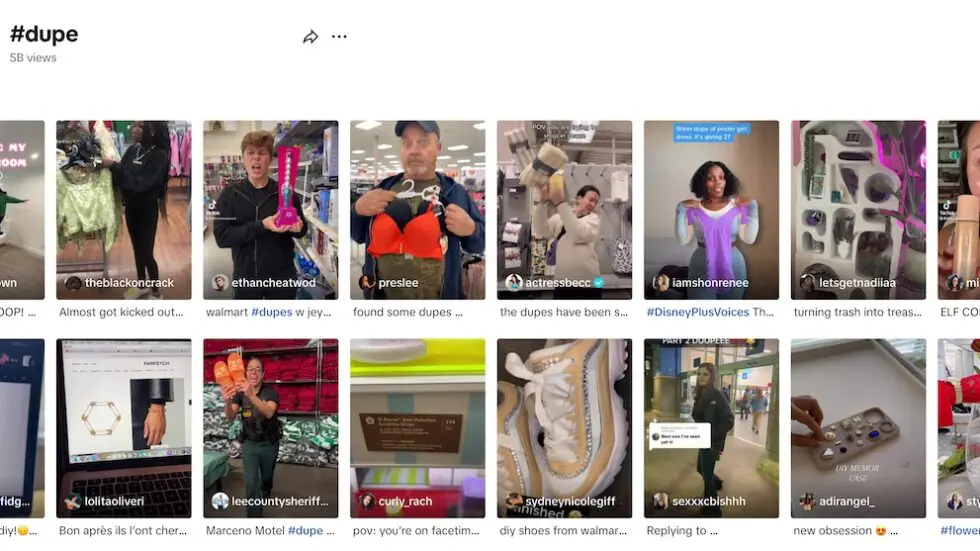What is Dupe Culture?
Dupe culture is reshaping the fashion industry.
Indeed, when it comes to staying on-trend without breaking the bank, more and more people go looking for fashion dupes. Social media — specifically TikTok, Instagram and Pinterest — have given rise to #dupe, #dupefashion, and other related tags. Similar to the de-influence trend, dupe culture is basically a counterpoint to a brand’s best marketing efforts.
What Is a Fashion Dupe?
Fashion dupes are different from counterfeit products, but they come from a similar place.
Counterfeits masquerade as the brand, using logos and other protected trademark elements to pass themselves off as the real thing. Fashion brands have some legal recourse against counterfeit products. At least in theory. Dupes don’t pretend to be anything other than a copy of the product they’re duping. They’ll often proudly proclaim themselves as a dupe.
Where counterfeit fashion is a game of whack-a-mole at best, counteracting dupes may be even more challenging for fashion brands. There’s no legal protection; dupes don’t infringe on obvious trademarks. They basically just say “oh, you like that [insert consumer fashion item here]? Well check this out, it looks the same but costs less.”
For fashion brands, navigating the fashion dupe trend can be tricky. The goal is to counteract dupe culture and not give credence to it.
Fashion brands need to stand out from the dupe culture knock-offs they inspire, but all the while dupe fashions are luring customers with lower prices on what often look like the exact same products.
One key for fashion brands who are drowning in a sea of dupes is to consider the conscious consumer vs the trend follower.

Understanding Dupe Culture
Ironically, dupes have become a trend in their own right.
‘Dupes’ is short for duplicates. Dupe fashions are knock-offs of high-end products. “Dupe culture” is a counterculture of sorts, made up of people seeking style on a budget.
Counterfeit fashions borrow on the cachet of iconic brands. They’re fakes that give the illusion that someone is wearing or carrying an iconic brand. People who wear or carry counterfeit fashion hope no one finds out. People who manufacture counterfeit fashion really hope no one finds out… because they’re breaking the law.
Dupe culture, on the other hand, sees people proudly proclaiming how much they saved by eschewing the designer label. Dupes don’t pretend to be the brand. If anything, they stand in opposition to the brand they’re duping.
Dupe culture is not just about affordability. It’s wrapped up in the guise of democratizing trends. If you’ve heard the phrase “buy nice or buy twice,” dupe culture is basically the opposite. Buy cheap, buy lots. That is both its strength and its weakness.
Counteracting Dupe Culture Fashion
Fashion dupes and dupe culture in general are parasitic in nature. That’s not editorializing, it’s the dictionary definition; “depending on another or others for existence or support without making a useful or adequate return.”
That said, the moral high-ground is perhaps not the best position for fashion brands to fight dupes and dupe culture.
Lululemon’s “Dupe Swap” strategy was called “brilliant” by Fast Company. The company invited people in LA to come to a special event to trade in their Lululemon Align dupes for the real deal. The campaign was successful as an in-person event, with 50% of those coming to trade up being new customers, according to the brand. It was also successful online, spreading the brand message as people recorded and shared themselves trading in their dupes for genuine article.
Dupe Swap was a fully fledged strategy to address dupes. It displayed and inspired confidence in the Lululemon brand. That is what’s required to tackle dupes head-on. It was the exception that proves the rule…
Don’t Take Aim at dupes or Dupe culture
It’s not true that “there’s no such thing as bad publicity.” In this case though, any publicity or attention dupes and dupe fashion get only serves to raise awareness.
Addressing dupes directly likely isn’t the best strategy. Instead, brands need to focus on their core values and value proposition. Dupes are all about fast and cheap. They copy as opposed to innovate. They follow as opposed to lead.
Brands can lean into their strengths, not to call out dupes directly but to help customers understand the difference for themselves.
Ask yourself, what makes my brand and my product different and unique? Dupes can only duplicate (it’s right there in the name). Their only “innovation” is on price, and cost is their only competitive advantage. So ask yourself what sets your brand apart. For example:
- Quality: is your product a “buy nice or buy twice” proposition?
- Is there a technical innovation such as a proprietary fabric or similar?
- Is there a genuine ethical sourcing or supply chain story to discuss?
- Is there an empowerment angle or another reason someone should choose the real deal over a dupe?
Dupe culture is movement. Counteracting dupe culture really comes down to knowing what it is that dupe fashions can’t copy, and leaning into that.
How Content Creators can Help
Dupe culture starts with content creators. Tapping content creators and social media influencers to take aim at dupes can be a smart approach.
BENlabs AI matches brands with the ideal content creators who align on values and on your goals as a brand marketer. With a great content creator marketing brief and with BENlabs AI cluster analysis finding the ideal audiences for your message, brands can counteract dupe culture knock-offs without adding fuel to the dupe culture fire.
Smart Creator Matching
BENlabs AI-powered Smart Creator Matching uses cluster analysis to surface and stack rank content creators who align with brand values and who have your target audience’s attention.





